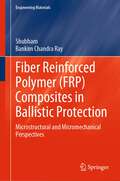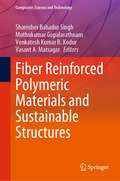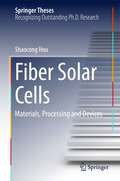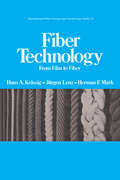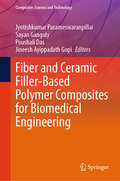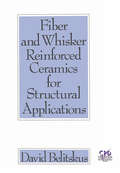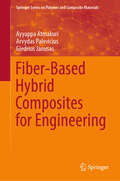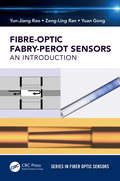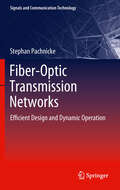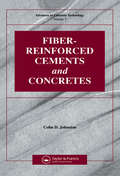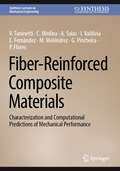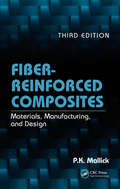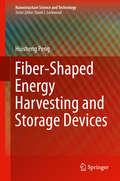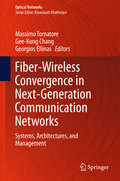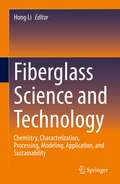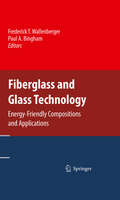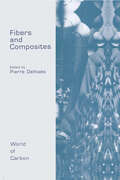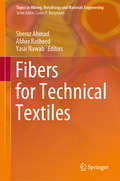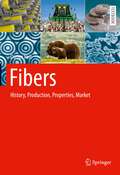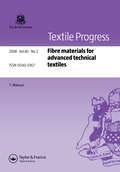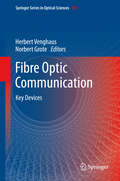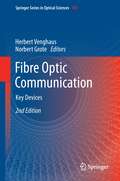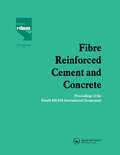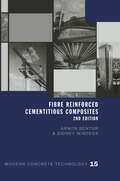- Table View
- List View
Fiber Reinforced Polymer: Microstructural and Micromechanical Perspectives (Engineering Materials)
by Bankim Chandra Ray ShubhamThis book highlights the pulchritudinous features of FRP composites emphasizing failure criteria referring to microstructural as well as micromechanical aspects. The potential and promises of this class of material as being explored for supercritical applications necessitate the analysis and assessment of FRPs with a spectrum of low to high strain rates. Additionally, constitutive modeling and shock properties of polymeric composites along with the data processing techniques and relevant theories for different characterization methods are conversed. The findings of previous studies available on mechanical characteristics of polymer composites under quasi-static and high-strain-rate circumstances are also discussed. The dearth of open literature and limited information culminate the need for this book which may eventually bridge the existing gap.
Fiber Reinforced Polymeric Materials and Sustainable Structures (Composites Science and Technology)
by Shamsher Bahadur Singh Muthukumar Gopalarathnam Venkatesh Kumar R. Kodur Vasant A. MatsagarThis book deals with the introduction of various kinds of advanced composite materials such as carbon fiber-reinforced polymer (CFRP), glass fiber-reinforced polymer (GFRP), aramid fiber-reinforced polymer (AFRP), and basalt fiber-reinforced polymer (BFRP). This book covers the advantages and disadvantages of these advanced composite materials. The primary advantages, such as high specific strength and stiffness, of advance composite materials result in lighter and durable structures. On the other hand, its linear elastic behavior till failure has been highlighted as the main disadvantage for their structural applications. This book also highlights the various forms in which the FRP components are tailored and stacked up to optimize its strength and stiffness to deliver the high-performance structural as well as non-structural components in its real-life application. The various forms in which FRP materials are developed are described such as uni-directional, cross-ply, angle-ply, hybrid, and functionally graded composites. In addition, various forms in which these materials stacked and/ bonded to fabricate the various structural and non-structural components are described. Most importantly, techniques to extract plant-based cellulosic fibers and its application to fabricate the various forms of sustainable composite products are described. In addition, development of nano-particle-enforced cellulosic fibers for sustainable industrial products has also been presented. Furthermore, the use of advanced composites and natural fiber-based composites has been demonstrated for repair, rehabilitation, and retrofitting of deficient structural systems. Moreover, the comprehensive overview of the state-of-the-art research on the test methods for material characterization at room and elevated temperature is presented which will be of high interest to scientists, researchers, students, and engineers working in the fields of composite materials such as FRPs and other forms of composites such as fiber-reinforced concrete (FRC). This book is also helpful for undergraduate, masters, and most importantly Ph.D. research scholars for developing their fundamental understanding on advanced composite materials and their applications in construction as well as industrial sectors.
Fiber Solar Cells
by Shaocong HouThis thesis presents the fundamental research and latest findings on novel flexible/wearable photovoltaic technology, and comprehensively summarizes the rapid developments in flexible photovoltaics, from traditional planar solar cells to fiber solar cells. It discusses the rational design of fiber solar cell materials, electrodes and devices, as well as critical factors including cost, efficiency, flexibility and stability . Furthermore, it addresses fundamental theoretical principles and novel fabrication technologies and their potential applications. The book provides practical information for university researchers and graduate students interested in flexible fiber photovoltaics, and inspires them to design other novel flexible/wearable electronics and textiles.
Fiber Technology: From Film to Fiber (International Fiber Science And Technology Ser. #4)
by Hans A. KrassigThis book is intended to fiber technologists, textile dealers, and textile salesmen a practical guideline to become acquainted with and to deepen their knowledge of the processes for the manufacture of film tapes, split-film yarns, and fibrillated film fibers.
Fiber and Ceramic Filler-Based Polymer Composites for Biomedical Engineering (Composites Science and Technology)
by Jyotishkumar Parameswaranpillai Poushali Das Sayan Ganguly Jineesh Ayippadath GopiThis book presents the latest development of fibre/ceramic-polymer composites for biocompatible applications, with a special emphasis on the effect of different types of fibre and ceramic fillers on the characteristics of the composites. The book contains chapters that cover fundamentals, materials used for composites, fabrication, classification, and biomedical applications. The first section of the book provides a brief overview of the fibre and ceramic-based composite materials while the subsequent sections cover the numerous types of fibre and ceramic polymeric composites with emphasis on their potential biomedical applications. Increasingly sophisticated biomedical technologies, such as tissue engineering and regenerative medicine, as well as genetic therapies and controlled drug delivery, are being developed at a breakneck pace, necessitating the development of new materials to meet the specific requirements of these fields. Single-component ceramic or polymer materials that are now available do not meet their requirements. Therefore, composites and hybrid composites have an important role to play. Aside from that, to completely meet the fundamental criteria such as biocompatibility, biodegradability, and acceptable mechanical qualities, it is necessary to find materials that can perform a variety of advanced activities at the same time. This book is a road map not only for the materials scientist but also for researchers, academics, technologists, and students working in composites for biomedical engineering applications.
Fiber and Whisker Reinforced Ceramics for Structural Applications (Materials Engineering)
by David BelitskusExamines all important aspects of whisker and fibre reinforced ceramic science and technology, offering a balanced account of developments in the field. The work shows how to improve the strength and stiffness of ceramic composites, at very high temperatures, without brittleness.
Fiber-Based Hybrid Composites for Engineering (Springer Series on Polymer and Composite Materials)
by Giedrius Janusas Arvydas Palevicius Ayyappa AtmakuriThis book brings together a collection of groundbreaking research papers, offering an in-depth exploration of the latest developments, methodologies, and future possibilities of natural fiber composites in the dynamic field of materials science and engineering. Within these pages, it discovers the intricate world of fabrication techniques for hybrid composites based on natural fibers and various matrix materials. This book unravels the secrets behind the enhanced mechanical properties of natural fiber hybrids, showcasing remarkable tensile strength, flexural strength, and modulus improvements. It explores the impact of alkaline treatments on the mechanical properties of reinforcement materials through detailed morphological studies and FTIR analyses. Comparative studies between epoxy-matrix-based and EcoPoxy (Bio resin) matrix-based hybrid composites reveal intriguing insights, while investigations into basalt and E-glass woven-fiber-based epoxy hybrid composites with graphite filler material showcase superior mechanical properties. Moreover, this book goes beyond presenting findings; it sets the stage for future research. Proposals for further investigations include exploring diverse chemical treatments for natural fibers, studying the effects of various filler materials, analyzing moisture absorption behavior, and expanding the application scope of natural fiber hybrid composites. Whether you're an experienced researcher, an engineering enthusiast, or a student entering the captivating realm of materials science, this book will be a valuable resource. This book takes a profound journey into the advancements, challenges, and potential applications of natural fiber hybrid composites, shaping the future of sustainable engineering solutions and innovative materials with advancements in natural fiber hybrid composites.
Fiber-Optic Fabry-Perot Sensors: An Introduction (Series in Fiber Optic Sensors)
by Yun-Jiang Rao Zeng-Ling Ran Yuan GongThe authors deliver a complete overview of fiber-optic Fabry-Perot (FFP) sensing technology, integrating the knowledge and tools of multiple fields including optics, sensing, micromachining, instrumentation, physics, and materials science. The main chapters discuss operating principles, microstructures, fabrication methods, signal demodulation, and instrumentation. This treatment spans the full range of structures (intrinsic/extrinsic, multimode fiber vs single-mode fibers), as well as advanced micromachining technologies and major interrogating and multiplexing methods for the formation of multi-point, quasi-distributed sensing networks. Readers will also gain a summary of state-of-the-art applications in oil, gas, and electricity industries, aerospace technology, and biomedicine. Yun-Jiang Rao is Dean of the School of Communication & Information Engineering, and Director of the Key Lab of Optical Fiber Sensing & Communications at the University of Electronic Science and Technology of China. Zeng-Ling Ran and Yuan Gong are both associate professors at the Optical Fiber Technology Research Laboratory of the University of Electronic Science and Technology of China.
Fiber-Optic Transmission Networks
by Stephan PachnickeNext generation optical communication systems will have to transport a significantly increased data volume at a reduced cost per transmitted bit. To achieve these ambitious goals optimum design is crucial in combination with dynamic adaptation to actual traffic demands and improved energy efficiency. In the first part of the book the author elaborates on the design of optical transmission systems. Several methods for efficient numerical simulation are presented ranging from meta-model based optimization to parallelization techniques for solving the nonlinear Schrödinger equation. Furthermore, fast analytical and semi-analytical models are described to estimate the various degradation effects occurring on the transmission line. In the second part of the book operational aspects of optical networks are investigated. Physical layer impairment-aware routing and regenerator placement are studied. Finally, it is analyzed how the energy efficiency of a multi-layer optical core network can be increased by dynamic adaptation to traffic patterns changing in the course of the day.
Fiber-Reinforced Cements and Concretes
by Colin D JohnstonThis book summarizes and simplifies the results of a considerable body of research and practical experience with a wide range of fiber-reinforced cementitious composites.
Fiber-Reinforced Composite Materials: Characterization and Computational Predictions of Mechanical Performance (Synthesis Lectures on Mechanical Engineering)
by C. Medina V. Tuninetti A. Salas I. Valdivia E. Fernández M. Meléndrez G. Pincheira P. FloresThis book provides a comprehensive overview of the current progress in fiber-reinforced plastics (FRP), covering manufacturing, mechanical behavior, and resistance performance. It includes the elastic and damage behavior of unidirectional FRP, and highlights the improvements achieved by adding multiwall carbon nanotubes. The material resistance is assessed through fatigue response, local behavior, local properties, and failure mechanisms, including crack density and microcrack propagation behavior. The book also explores the degradation of macroscopic mechanical properties such as elastic modulus and compressive strength versus plastic strains. Additionally, it focuses on the progress made in out-of-plane composite characterization and modeling response for simulations of critical mechanical parts currently used in different industries, thanks to advances in manufacturing techniques that allow for the production of increasingly complex and thicker geometries.
Fiber-Reinforced Composites: Materials, Manufacturing, and Design, Third Edition (Mechanical Engineering)
by P.K. MallickThe newly expanded and revised edition of Fiber-Reinforced Composites: Materials, Manufacturing, and Design presents the most up-to-date resource available on state-of-the-art composite materials. This book is unique in that it not only offers a current analysis of mechanics and properties, but also examines the latest advances in test metho
Fiber-Shaped Energy Harvesting and Storage Devices
by Huisheng PengThis comprehensive book covers flexible fiber-shaped devices in the area of energy conversion and storage. The first part of the book introduces recently developed materials, particularly, various nanomaterials and composite materials based on nanostructured carbon such as carbon nanotubes and graphene, metals and polymers for the construction of fiber electrodes. The second part of the book focuses on two typical twisted and coaxial architectures of fiber-shaped devices for energy conversion and storage. The emphasis is placed on dye-sensitized solar cells, polymer solar cells, lithium-ion batteries, electrochemical capacitors and integrated devices. The future development and challenges of these novel and promising fiber-shaped devices are summarized in the final part. This book is the first to introduce fiber-shaped electronic devices, which offer many fascinating advantages compared with the conventional planar structure. It is particularly designed to review the state-of-art developments in fiber-shaped devices for energy conversion and storage. The book will provide a valuable resource for researchers and students working in a wide variety of fields such as advanced materials, new energy, electrochemistry, applied physics, nanoscience and nanotechnology, and polymer science and engineering. Huisheng Peng, PhD, is a Professor and Associate Chair of the Department of Macromolecular Science and PI of the Laboratory of Advanced Materials, Fudan University, Shanghai, China.
Fiber-Wireless Convergence in Next-Generation Communication Networks
by Georgios Ellinas Massimo Tornatore Gee-Kung ChangThis book investigates new enabling technologies for Fi-Wi convergence. The editors discuss Fi-Wi technologies at the three major network levels involved in the path towards convergence: system level, network architecture level, and network management level. The main topics will be: a. At system level: Radio over Fiber (digitalized vs. analogic, standardization, E-band and beyond) and 5G wireless technologies; b. Network architecture level: NGPON, WDM-PON, BBU Hotelling, Cloud Radio Access Networks (C-RANs), HetNets. c. Network management level: SDN for convergence, Next-generation Point-of-Presence, Wi-Fi LTE Handover, Cooperative MultiPoint.
Fiberglass Science and Technology: Chemistry, Characterization, Processing, Modeling, Application, and Sustainability
by Hong LiThis book highlights recent developments in fiberglass research and technology development, including high-performance fiberglass chemistry; in-depth glass network structure information derived from the-state-of-the-art spectroscopic measurements, molecular dynamics simulations, and their correlations with properties; fiber surface chemistry in relation to sizing chemistry - a critical part of composite performance; fiber process stability; fundamental understanding of the batch-to-melt conversion processes and melt flow simulations; and environmental concerns such as energy efficiency and emission of volatile species, which are key to environmentally-friendly product manufacturing. The book aims to guide fiberglass researchers and manufacturers towards better awareness and, perhaps, provides potential options for global ecosystem management. More than 500 current references are included, which will enable researchers from fiber glass industry and research institution access to the most recent progress in fiberglass science and technology. Advances scientific understanding of fiberglass-forming processes, rising in popularity as a building material throughout the world;Describes the current advances in the structure and formation of fiber glass, beginning with chemistry, a wide range of characterizations, and processes, through to applications;Contains information on environmental aspects of fiberglass production, addressing energy consumption and emission.
Fiberglass and Glass Technology
by Frederick T. Wallenberger Paul A. BinghamFiberglass and Glass Technology: Energy-Friendly Compositions and Applications provides a detailed overview of fiber, float and container glass technology with special emphasis on energy- and environmentally-friendly compositions, applications and manufacturing practices which have recently become available and continue to emerge. Energy-friendly compositions are variants of incumbent fiberglass and glass compositions that are obtained by the reformulation of incumbent compositions to reduce the viscosity and thereby the energy demand. Environmentally-friendly compositions are variants of incumbent fiber, float and container glass compositions that are obtained by the reformulation of incumbent compositions to reduce environmentally harmful emissions from their melts. Energy- and environmentally-friendly compositions are expected to become a key factor in the future for the fiberglass and glass industries. This book consists of two complementary sections: continuous glass fiber technology and soda-lime-silica glass technology. Important topics covered include: o Commercial and experimental compositions and products o Design of energy- and environmentally-friendly compositions o Emerging glass melting technologies including plasma melting o Fiberglass composite design and engineering o Emerging fiberglass applications and markets Fiberglass and Glass Technology: Energy-Friendly Compositions and Applications is written for researchers and engineers seeking a modern understanding of glass technology and the development of future products that are more energy- and environmentally-friendly than current products.
Fibers and Composites (World of Carbon)
by Pierre DelhaèsThis book is devoted to advanced composite materials based on carbon fibers issued from different precursors and various matrices. Written by internationally recognized specialists, Fibers and Composites is divided into three main parts. The first presents an alternative way to process and prepare carbon fibers issued from either natural or art
Fibers for Technical Textiles (Topics in Mining, Metallurgy and Materials Engineering)
by Yasir Nawab Sheraz Ahmad Abher RasheedThis book discusses the properties of fibres used in manufacturing technical textiles, highlighting the importance of material selection in terms of cost, end-user requirements and properties. It also discusses the classification of technical textiles, and describes the details of each category, such as the properties, applications, advantages and drawbacks. As such, it is a valuable resource for all those interested in advanced textiles.
Fibers: History, Production, Properties, Market
by Dieter VeitThis textbook covers the production of all relevant natural and man-made fibers, their inner structure, properties, applications, markets and historic development. More than 1,600 photos, maps and sketches complement the text. The properties of important fibers are compared in a large number of tables and graphics to simplify selecting an appropriate fiber for a given application.
Fibre Bragg Grating and No-Core Fibre Sensors (SpringerBriefs in Physics)
by Suzairi Daud Jalil AliThis book focuses on the development and set-up of fibre Bragg grating (FBG) and no-core fibre (NCF) sensors. It discusses the properties of the sensors and modelling of the resulting devices, which include electronic, optoelectronic, photovoltaic, and spintronic devices. In addition to providing detailed explanations of the properties of FBG and NCF sensors, it features a wealth of instructive illustrations and tables, helping to visualize the respective devices’ functions.
Fibre Materials for Advanced Technical Textiles (Textile Progress #No. 27)
by T. MatsuoThis paper tries to give an overview on technologies using fibrous materials for contributing to environmental and resource matters. The technologies for water treatment include bio-reactive treatment system using membrane hollow fibre, desalination using Ro hollow fibre, purification of water work using UF or MF hollow fibre, purification of recyc
Fibre Optic Communication
by Herbert Venghaus Norbert GroteThe book gives an in-depth description of the key devices of current and next generation fibre optic communication networks. In particular, the book covers devices such as semiconductor lasers, optical amplifiers, modulators, wavelength filters, and detectors but the relevant properties of optical fibres as well. The presentations include the physical principles underlying the various devices, the technologies used for the realization of the different devices, typical performance characteristics and limitations, and development trends towards more advanced components are also illustrated. Thus the scope of the book spans relevant principles, state-of-the-art implementations, the status of current research and expected future components.
Fibre Optic Communication: Key Devices (Springer Series in Optical Sciences #161)
by Herbert Venghaus Norbert GroteThe book gives an in-depth description of key devices of current and next generation fibre optic communication networks. Devices treated include semiconductor lasers, optical amplifiers, modulators, wavelength filters and other passives, detectors, all-optical switches, but relevant properties of optical fibres and network aspects are included as well. The presentations include the physical principles underlying the various devices, technologies used for their realization, typical performance characteristics and limitations, but development trends towards more advanced components are also illustrated. This new edition of a successful book was expanded and updated extensively. The new edition covers among others lasers for optical communication, optical switches, hybrid integration, monolithic integration and silicon photonics. The main focus is on Indium phosphide-based structures but silicon photonics is included as well. The book covers relevant principles, state-of-the-art implementations, status of current research as well as expected future components.
Fibre Reinforced Cement and Concrete: Proceedings of the Fourth RILEM International Symposium
by R. N. SwamyThis book presents the latest research development on fibre reinforced cementitious materials, especially those related to ageing and durability. The book forms the Proceedings of the International Symposium held at Sheffield in July 1992, the latest in a series of RILEM symposia on this subject, organised by RILEM Technical Committee 102-AFC Ageing and Durability to Fibre Cement Composites.
Fibre Reinforced Cementitious Composites
by Arnon Bentur Sidney MindessAdvanced cementitious composites can be designed to have outstanding combinations of strength (five to ten times that of conventional concrete) and energy absorption capacity (up to 1000 times that of plain concrete). This second edition brings together in one volume the latest research developments in this rapidly expanding area. The book is split
